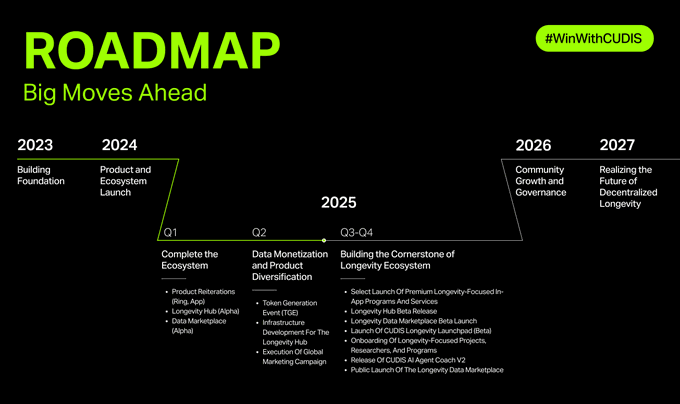CUDIS: A Web3 Protocol Redefining the Value of Health Data
CUDIS is a decentralized longevity incentive protocol developed by BeatBit Wellness Lab. It aims to solve three major issues in the traditional health data industry through its “Health to Earn” model: lack of user data ownership, insufficient sustainability of healthy behavior, and data silos in medical research. In 2024, the project launched its smart ring hardware, with over 20,000 units sold. It has built a four-layer technical architecture that integrates hardware monitoring, AI analysis, and blockchain-based data ownership. On June 5, 2025, its native token $CUDIS will undergo TGE, becoming the first human data tokenization project to list on a major exchange.

This Token Insights article explores how CUDIS realizes health data ownership and incentives through blockchain, analyzing its hardware integration model.
Technical Architecture: From Data Collection to Value Transformation
Deep Integration of Hardware and Blockchain
CUDIS’s core innovation lies in seamlessly connecting medical-grade smart rings with blockchain protocols:
-
Data Collection Layer: The ring is equipped with 10 types of sensors (including SpO2 and GSR monitoring), generating encrypted health reports every 3 minutes;
-
Privacy Protection Layer: Uses zero-knowledge proofs to generate verifiable credentials (LDID); raw data is stored on IPFS, only the hash is recorded on-chain;
-
Value Transformation Layer: Users can anonymously sell datasets such as sleep patterns and exercise habits to pharmaceutical or insurance companies, with transactions settled in $CUDIS—up to 85% revenue share for users.
AI-Driven Health Optimization System
Distributed AI nodes analyze user data streams and dynamically generate personalized health plans:
-
Real-Time Intervention: If the system detects consecutive late nights, it auto-pushes $CUDIS incentive tasks (e.g., “Sleep before 11PM to earn 50 tokens”);
-
Disease Prediction: In partnership with the Scripps Research Institute, it has developed an Alzheimer’s early warning model with 37% higher accuracy than traditional methods.
Tokenomics
Triple Token Utility Design
With a total supply of 1 billion tokens, $CUDIS creates a closed-loop economic system:
-
User Incentives: Completing daily health goals (e.g., 8 hours of sleep) earns CUDIS tokens, with active users earning 15–120 CUDIS/month;
-
Data Trading Medium: Research institutions pay CUDIS to access compliant datasets, with average prices at 200 CUDIS/10,000 entries;
-
Governance and Staking: Token holders vote on protocol upgrades, and node operators stake tokens to provide AI computing power, earning 75% of transaction fees.
Industry Breakthrough in Health Data Assetization
Disruptive Innovation in Traditional Healthcare Models
CUDIS demonstrates the feasibility of “user-driven data pricing”:
-
Data Ownership Case: User “0x7d3” sold three months of sleep data to Novartis for $1,200;
-
Insurance Integration Pilot: Partnered with Allianz to test a dynamic premium model—users exercising daily enjoy up to 30% premium discounts.
On-Chain Practice of Longevity Economy
The project has built the first decentralized longevity ecosystem:
-
Research Crowdfunding: Users can donate anonymous data to support anti-aging research and share patent profits based on contribution level;
-
Longevity NFT: Completing daily health tasks for 365 days enables minting of a “Centenarian NFT” with governance privileges.
Risks and Compliance Pathways
Privacy and Regulatory Tensions
-
GDPR Compliance Pressure: The EU requires health data to be stored locally; CUDIS uses Frankfurt-based proxy nodes to meet regional compliance;
-
SEC Jurisdiction Dispute: The U.S. SEC may define health behavior incentives as unregistered securities. The project has allocated 20% of its tokens to a legal compliance fund.
Market Competition and Model Sustainability
-
Dominance of Traditional Giants: Oura Ring holds 62% of the smart ring market, but its closed data ecosystem presents a differentiation opportunity;
-
Inflation Control Mechanism: A 12% annual inflation rate could trigger sell pressure; the protocol employs a 50% fee-based buyback-and-burn mechanism to balance supply and demand.
Compliance updates can be tracked via JuCoin Compliance Center for in-depth analysis reports.
Bottlenecks in the Web3 Health Track
Two major current challenges:
-
Hardware Penetration: The $299 price of the smart ring limits user growth; a subscription model is planned to lower the entry barrier;
-
Data Standardization: Working with IEEE to develop standardized on-chain health data formats to solve multi-source compatibility issues.
Future Development: From Data Network to Longevity Ecosystem
CUDIS’s 2025 roadmap focuses on three major leaps:
Cross-Chain Expansion (Q3): Integrate Solana VM and Ethereum Rollup to support multi-chain health data aggregation;
AI Coach Upgrade (Q4): Introduce multimodal interaction with AR glasses for real-time exercise coaching;
RWA Connection (2026): Health data credentials can serve as on-chain credit assets for low-interest loans.
If its “human data assetization” model proves viable, it could catalyze a trillion-dollar longevity economy, shifting medical R&D from institution-centered to patient-democratized paradigms.





